Recent Palaeoethnobotanical Research at Scowlitz
a talk presented to the Archaeological Society of British Columbia,
at Vancouver, BC, April 12, 2000
by Natasha Lyons
INTRODUCTION:
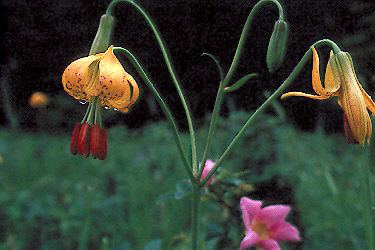 SLIDE 1. Tiger lily
SLIDE 1. Tiger lily
This talk will focus on palaeoethnobotanical analysis of deposits located within the village proper at Scowlitz. In particular, I will discuss the major questions addressed in my thesis research, the approach taken to examining these, and how the kinds of plant remains that I recovered fit into the broader picture of site use.
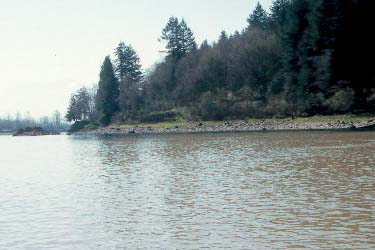 SLIDE 2: Front terrace of the Scowlitz site.
SLIDE 2: Front terrace of the Scowlitz site.
The deposits that I have particularly focused on in my thesis research are those located on the front part of the terrace where the large-scale areal excavations have been conducted. As suggested by Doug Brown, these excavations have had their successes and challenges. At this point, we’ve been able to define a series of deposits that form part of the chronology of the Scowlitz site, beginning about 3000 years ago and extending into the historic period. This has not meant continual occupation, but perhaps continual use and/or perceived ownership by a group of aboriginal peoples in this area.
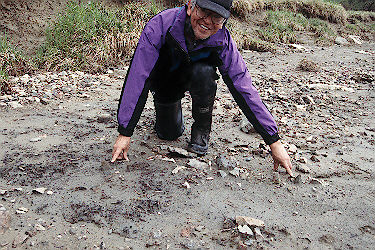 SLIDE 3: Clifford Hall retrieving wet-site materials.
SLIDE 3: Clifford Hall retrieving wet-site materials.
Prior to my research, wet-site mitigation was conducted by the University of British Columbia and reported on, in particular, by Kitty Bernick. Continued mitigation work on the wet-site has continued as the banks of the site erode more and more each year. The Scowlitz wet site has provided much information about organic artifacts such as cordage, basketry, clothing, hafting for knives etc. The work that I’m doing, in turn, provides a complement to wet-site investigations because it focuses on the charred component of the plant assemblage. These sets of remains are quite different due to the depositional processes that preserved them.
 SLIDE 4. The 1995 trench showing structure 4.
SLIDE 4. The 1995 trench showing structure 4.
My thesis research has focused on three site deposits. The oldest of these is called structure 4, a house that is one of oldest occupations known on site, dated at 3000 years.
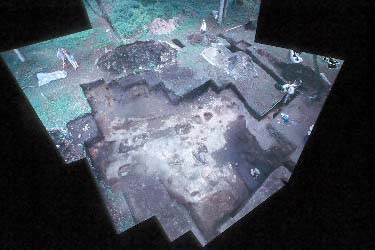 SLIDE 5 Composite photo of structure 3, fully excavated.
SLIDE 5 Composite photo of structure 3, fully excavated.
The second deposit is another house, structure 3, which dates to the Marpole Phase, at 2400 years old. It is much bigger than structure 4. There are other houses on site located temporally between these occupations which suggest that continual village occupation occurred between these two deposits. This slide shows structure 3 at the end of the 1999 season when it had been fully exposed.
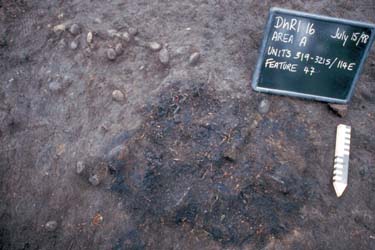
SLIDE 6 Hearth in structure 3, note the boiling stones in the upper left.

SLIDE 7. The orange strata in the lower left and on the surface are traces of multiple intensive burning events.
Finally, the third deposit I examined in my research is called the burned orange deposit. It is located stratigraphically above structure 3 and extends about 70 x 20 m along the terrace. This deposit is characterized by intensive burning and a lack of structural features. Interestingly, site use during this occupation, between 800 and 1000 years ago, overlaps temporally with the activities related to the building and maintenance of the mortuary complex on site.
 SLIDE 8. E.S. Curtis photo of Cowichan woman collecting tule for mats and basketry.
SLIDE 8. E.S. Curtis photo of Cowichan woman collecting tule for mats and basketry.
The major questions I asked about these occupations include the following. First, what is the nature of site socioeconomy associated with each deposit? Economic aspects encompass the uses of plants related to subsistence, housing, clothing, storage, and other day to day necessities. Social aspects, in turn, include the use of plants in activities related to ritual, ceremony, and feasting.

SLIDE 9. Nicole Oakes & Dr. Vera Kletz near Scowlitz. Note the abundant plant life.
The second major question is: what was the nature human/plant interaction at the local level? This question is related to the breadth of the economy and the extent of resource use. For instance, were most of the resources represented in the plant assemblage collected within proximity to the site environs. And, were there also non-local resources that could have been acquired through travel or trade?

SLIDE 10. Coast Salish house interior (Paul Kane).
Finally, what is the nature of each of these occupations? This question relates to the relative permanence of occupation. Were the houses occupied for part or all of the year? And, what was the duration of occupation related to the burned orange deposit?
Because the ethnographies for the Upper Sto:lo provide relatively little information about site use and settlement patterns, I developed a series of hypotheses to investigate how the archaeological record compared with the historic and ethnographic accounts. The relative permanence of occupation for each deposit was determined using plant remains as seasonal indicators. Plants, like fauna, are useful for determining site seasonality in temperate climates because they follow predictable morphological changes through the seasons.
COLLECTION AND SAMPLING:
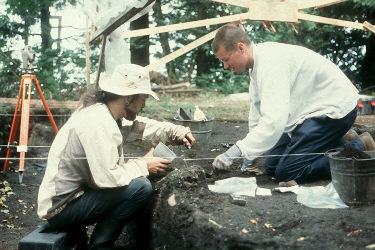
Slide 11. Paul and Chris collecting samples in 1997.
Over several seasons of excavation at Scowlitz, we have employed a rigorous sampling strategy. All deposits were systematically sampled in one of several ways: (a) column samples were taken for stratigraphic control; (b) when encountered, we attempted to sample 100% of floors and surfaces; and finally (c) bulk samples were collected in features and other interesting finds.
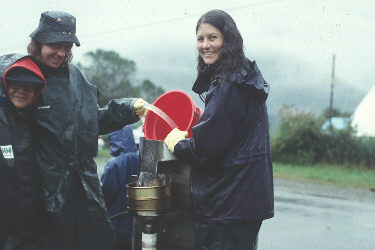 SLIDE 12. Betty Charlie, Natasha Lyons and Dr. Dana Lepofsky conducting flotation in the beautiful weather at Scowlitz camp.
SLIDE 12. Betty Charlie, Natasha Lyons and Dr. Dana Lepofsky conducting flotation in the beautiful weather at Scowlitz camp.
Most of the samples were processed through flotation analysis in the field. Flotation separates the light fraction, including charred and uncharred plants, from the heavy fraction, including lithic debitage and faunal remains.
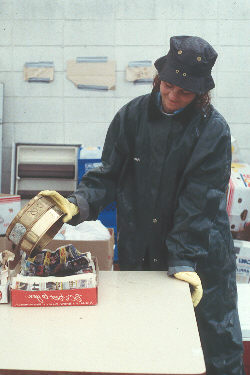 SLIDE 13. After flotation is complete, these fractions are placed on lined flats to air-dry.
SLIDE 13. After flotation is complete, these fractions are placed on lined flats to air-dry.
When it came time to sample for analysis, I attempted to encompass the full range of features types in each deposit—in the household deposits, these were floors, hearths, and midden pits, in the burned orange deposit, those ubiquitous in situ burns, activity surfaces, and cooking pits.
RESULTS:
The first comment about results should be about the abundance of remains. That is, lots and lots of charred plant remains were recovered from Scowlitz. As expected, abundance was greater in contexts where burning occurred, such as in hearths and burn features, but plant remains were also present in lesser amounts on floors and activity surfaces, largely because of taphonomic processes. The quantity of remains recovered is probably not remarkable for the coast, since plant remains become inert to microbial activity after they are charred.
Secondly, a broad diversity of plant remains was recovered, including needles, conifer buds, seeds, charcoal, tissues, among other macroremains. Seed and charcoal taxa were present in both large and small quantities, likely reflecting the use major and minor resources.
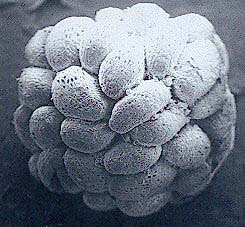 SLIDE 14. Charred salal berry (SEM).
SLIDE 14. Charred salal berry (SEM).
Plant foods are represented by charred seeds. Major plant foods, which appear to have been intensively processed on site, include salal and red elderberry.
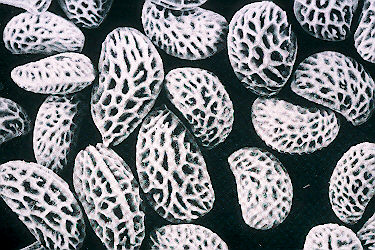 SLIDE 15. Salmonberry (SEM).
SLIDE 15. Salmonberry (SEM).
Minor plant foods are those that were only consumed fresh in season, and include salmonberry, currants, hawthorns, strawberries, among others in the seed assemblage.
 SLIDE 16. Big-leaf maple wood cross section.
SLIDE 16. Big-leaf maple wood cross section.
The charcoal assemblage also reflects the use of major and minor resources. Big-leaf maple was the most ubiquitous wood in the charcoal assemblage, followed by red alder, and Douglas-fir. These wood resources are all known ethnobotanically as preferred fuel-woods. These taxa, as well as a wide diversity of other wood taxa recovered from the charcoal assemblage, were also potentially used for additional technological purposes such as construction, carving, implement-making, dyeing and tanning. Direct evidence for construction is derived from several charred redcedar planks associated with the household deposits.
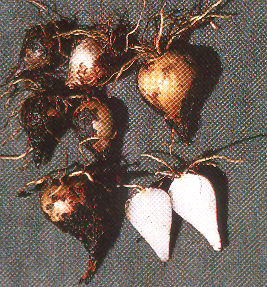
SLIDE 17. Blue camas bulbs.
A final category of macroremains is ‘tissues’, which are the charred remains of starchy ‘root’ foods such as wapato, lilies like nodding and hooker’s onions, and camas, among many others. These remains are highly fragmentary in the archaeological record; in fact, they cannot be distinguished even to the family level. However, with further experimentation, like Terry Spurgeon’s work with wapato in Katzie territory, and the development of comparative collections, we may at some point develop archaeological signatures for these various starchy root foods. Their presence in the archaeobotanical assemblage at Scowlitz, however sparse, indicates that these resources were being utilized, and possibly processed or dried for winter storage.
DISCUSSION:
My interpretations of site use and socioeconomy associated with the three deposits are based on the patterning of both archaeological and archaeobotanical remains. I came up with some very interesting results that, inevitably, raise further questions about the history of site use at Scowlitz.

SLIDE 18. Front terrace, the location of the burned orange deposit.
The burned orange deposit, provides evidence of a repeated use of Scowlitz as a base camp from spring through fall. There are no structural remains associated with this deposit and therefore no winter occupation. There is evidence for intensive plant food processing and possibly for fauna as well. The latter is difficult to determine because the faunal remains are in such poor condition.
Because the burned orange deposit overlaps temporally with the complex of mounds and cairns on site, it is unclear how these activities relate to mortuary activities. If this occupation was mundane in nature, it means that the site was used simultaneously in mundane and ritual manners. Alternatively, the burned orange deposits may have been related in some fashion to ritual activities, such as the practice of the feeding the dead. In this case, the intensive summer occupation may be related to custodial or caretaker duties.

SLIDE 19. Aerial photo of the confluence of the Harrison and Fraser Rivers.
The household occupation of structure 3, at c. 2400 BP, was a year-round occupation. Archaeobotanical evidence indicates early spring through late fall occupation. Archaeological evidence, in turn, demonstrates permanent house remains and therefore
likely winter occupation of the site. It appears that during residence of this household, at least part of the population remained on site in the summer to process both plants and animals (faunal processing associated with this occupation is demonstrated through the presence of a number of earth ovens), while other task groups dispersed to harvest resources up- and down-river, and in the uplands. Village residents probably re-grouped on site in the fall to settle in for the winter.
Evidence for the year-round occupation of structure 3 is notable since most ethnographers have characterized the Upper Fraser Valley as a place of transience and low population density. However, the extensive archaeological remains throughout the area, in addition to this new evidence for year-round seasonality, seem to counter this idea. Permanent, year-round occupations are suggested by evidence in areas beyond Coast Salish territory; among the Nuu-cha-nulth, the Makah, the Kwaguilth, and the Tsimshian. As such, there seems little reason why, given the abundance and predictability of resources, and providing a stable sociopolitical environment, local communities on the Fraser River would not maintain year-round residence.
Finally, the oldest house that I examined in this analysis, structure 4, basically had too little archaeological or archaeobotanical data to assess the nature of occupation. I think we can expect, given more data, that it was quite similar to structure 3, though this awaits further analysis.
CONCLUSIONS:
The results of archaeobotanical analysis at Scowlitz, in combination with household and mound research, shows the strength of using of multiple lines of evidence for investigating site and regional use, in this case at Scowlitz and the Upper Fraser Valley region. In addition, this particular project, which started out being largely an experiment to investigate the nature of an archaeobotanical assemblage at Scowlitz, has shown the utility of plant data for addressing a range of questions concerning settlement patterns and socioeconomy at the site, and potentially throughout the Northwest Coast as a whole.
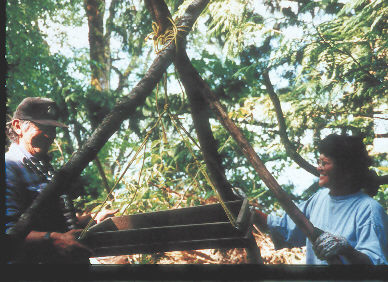
SLIDE 20. Betty Charlie and Clifford Hall, Scowlitz community members.
Much of the current research at Scowlitz is guided by the Scowlitz First Nation's concern and interest in their heritage and archaeological resources. I would like to extend thanks to the people of Scowlitz for teaching us so much and for their continued support of this project.
CREDITS:
Many thanks to Ms. Betty Charlie and Mr. Clifford Hall, the Scowlitz First Nation, especially the Band Council, and Scowlitz community members. Many thanks also to Dr. Dana Lepofsky, Dr. Michael Blake, Mr. Doug Brown, Ms. Nicole Oakes, Ms. Sandra Morrison, Ms. Joyce Johnson, field school students from the University of British Columbia and Simon Fraser University. Special thanks to Dr. Barbara Winter for doing this web page.

